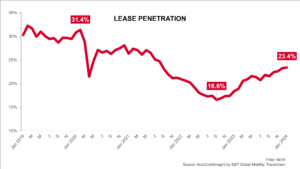Our culture is shifting toward a rental and subscription mindset across various industries. Many Americans subscribe to numerous streaming platforms and regularly order meal kits. Additionally, while tuxedo rentals have long been common, rental services for other types of formalwear are also becoming more popular. This indicates a growing trend among Americans who no longer feel the need to own everything necessary for every occasion.
This shift is evident in the automotive retail industry as well, where leasing has gained popularity due to affordability challenges, especially after experiencing a decline during the COVID-19 pandemic. In 2019, approximately 30% of customers chose leasing. By February 2020, just before the COVID-19-related shutdowns, leasing peaked at 31.4%, according to AutoCreditInsight by S&P Global Mobility and TransUnion. However, lease penetration then trended downwards, reaching a low of 16.6% in September 2022. It has since rebounded to 23.4% at the beginning of this year, prompted by rising prices and higher interest rates. Not only are consumers increasingly turning toward leasing, but dealers who capitalize on this trend have an opportunity to build a portfolio of customers who are likely to return at the end of their leases to explore other options.

Table of Contents:
How Dealers Can Capitalize on Leasing
Consumers increasingly see the benefits of leasing, especially in the face of affordability concerns. It’s important that dealers present a lease option for every vehicle a customer is interested in and equip sales advisors to communicate the benefits of leasing.
“Dealerships should turn to leasing as a tool to address increasing monthly payments,” said Joey Imparato, vice president of sales and performance management at Market Scan. “The benefits are clear: lower customer payments, three-year sales cycles and better access to young used cars.”
The opportunities leasing offers dealers are not new, and dealers have a new opportunity as customers’ interest in leasing grows. Leasing is a great way for dealerships to build their portfolio of customers who are required to return to the dealership at lease-end, offering an additional touchpoint and opportunity to sell another vehicle. Customers who purchase or finance vehicles may never return to the dealership.
However, most dealerships only have a couple of sales advisors who are comfortable working lease deals. Education is essential to make sure the entire sales team is on the same page. The most effective sales team understands that lease customers get more vehicle for less money each month. However, showing customers all their options so they too understand the advantages of leasing is essential.
Salespeople should show customers a wide variety of options available to them – for example, leases with a range of down payments and loans based on different term lengths. Market Scan’s mDesking solution provides these options in seconds by pulling data from lenders across the country. Offering choice demonstrates that a dealer truly wants what’s best for their customers. This transparency will enable customers to “close their own deal” and find what best fits their lifestyle while building dealership loyalty.
When customers return at the end of their leases, they’ll expect the same treatment and full spectrum of choices as they decide whether to lease again or select a finance deal. While leases offer undeniable advantages for dealerships, dealers who consistently provide information for all finance and leasing options will ultimately build something much more valuable – loyal customers who recommend the dealership to their families and friends.
Why the Culture Shift?
Vehicle prices are much higher than in previous decades, with the average manufacturer’s suggested retail price (MSRP) for a new vehicle at $50,284, as of the beginning of April 2024, according to S&P Global Mobility. Due to these high prices, many customers who want to finance their vehicle end up paying the vehicle off over a longer term – six or seven years – all while the vehicle depreciates.
People who purchase tend to replace their vehicles well ahead of contract maturity, often leading to a trade with negative equity – meaning customers end up owing more on a vehicle than what it is worth as a trade. According to data from S&P Global Mobility with TransUnion, new loan customers who were in a contract longer than 60 months, returned to market to buy a new car after just 40 months.
On top of this, most new vehicle warranties expire after three years or 36,000 miles, pushing repair costs to customers and increasing the risk of big-ticket repairs as vehicles age. Vehicles also become increasingly outdated and no longer have the latest safety and convenience features. If customers want to turn in vehicles before they finish paying them off, what they owe is added to the total price of the next vehicle they finance, so the customer owes more than the new vehicle is worth right off the bat.
It’s easy to see how customers can end up stuck in financing deals for the rest of their lives. For customers who pay monthly for their vehicles with no end in sight due to financing terms, it makes sense to lease instead, as the monthly rate for the same vehicle is always lower and the frequency of payments is the same. Additionally, lease terms are often shorter, enabling customers to upgrade their vehicles every few years for the latest safety and technology features.
At the end of their lease terms, customers have more options. They can enter a finance deal to purchase the vehicle they’ve been leasing (this is advantageous if the vehicle’s value is higher than the contracted residual value), or they can lease another vehicle (a great option if they want that new-car smell and the latest technologies). They can also choose to finance a different vehicle altogether. Leasing ensures customers can choose vehicles and payment options that match their lifestyles on a consistent basis, enabling them to shift as their lives change.
Considering these benefits and pairing them with the fact that many customers do not feel the need to own a vehicle, it’s easy to see why many are open to leasing.
Challenges Remain Due to Misconceptions
There are customers who remain hesitant to lease due to a lingering desire to own vehicles and the misconception that leases are only for low-mileage drivers. While dealers can’t change their customers’ ownership goals beyond demonstrating the advantages of leasing, there is a lot of flexibility when it comes to structuring a lease – increasing miles, term and cash-down. Customers who want to avoid a monthly payment can even structure a one-pay lease, which rolls all payments into one lump sum but generally costs less than the sum of monthly payments.
Market Scan’s mDesking solution includes a mileage calculator that enables dealers to input their customers’ desired mileage and then finds lenders that will finance the lease. Dealerships who rely solely on their captive lender to calculate lease terms risk losing customers who need high-mileage leases and help to entrench misconceptions that drive customers away from leasing. Through Market Scan, dealers can see every published price available to a customer, enabling customers to choose the deals that work best for them. When customers make the final choice from a range of options, they retain control of their purchases, and dealerships provide positive experiences that increase loyalty.
As customers accept a leasing model, they agree to build deeper relationships with their dealerships through their willingness to work with the dealer again when they turn in their keys. While this is beneficial for dealers, it increases the importance of retaining these customers through transparency and top-notch service. As customers’ expectations change, the most successful dealers will serve their needs every step of the way.
Click here to learn more about Market Scan’s dealer desking solutions.

